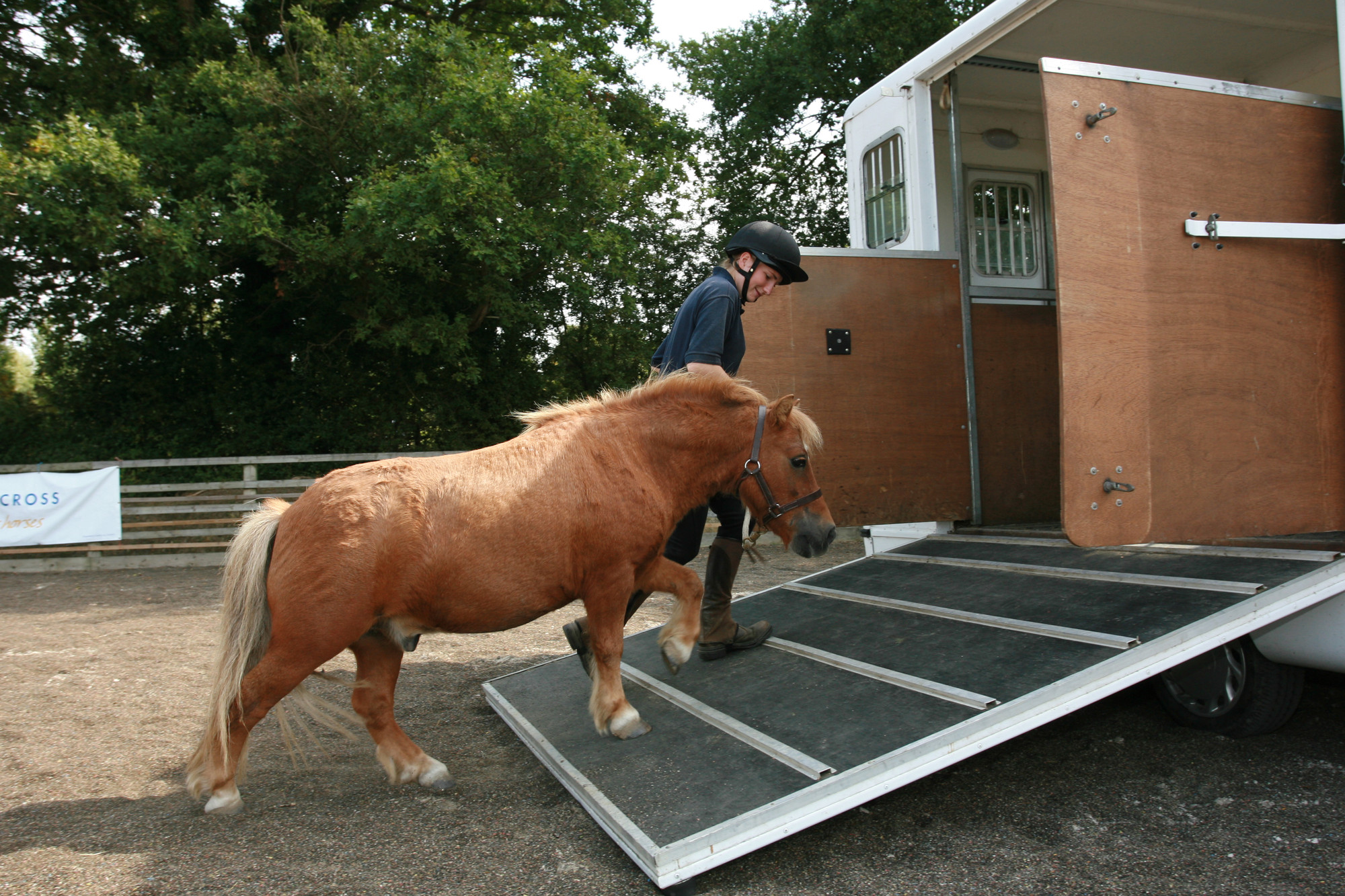
Loading and transporting horses
Before you transport your horse anywhere, there are a few things you’ll need to consider including training and protective clothing.
There are many reasons you may need to transport your horse, from occasional visits to the vet and moving homes, to more frequent shows or events. Whatever the reason for the journey, it’s important that your horse is safe and comfortable to help minimise stress.
Note
Your horse’s passport must always be kept with them, including during travel.
Preparing your horse for travel
You’ll need to be fully prepared for any transport situation, ensuring that your horse is happy to load and travel.
Bad experiences when loading or travelling can leave a lasting impact on a horse, so it’s important to prepare them well in advance. A horse being difficult to load is a common problem but is preventable and can be resolved with patience and positive training.
Training your horse to load
Training a horse to load should not be left until the last minute – never suddenly decide to load your horse when you’re in a hurry and short of time. It can be quite scary for a horse to walk on to a trailer ramp and into a small space, so you’ll need use a training method that does not frighten or punish your horse, or risk either of your safety.
Tip
Clicker training and target training are both positive, useful ways of introducing your horse to loading onto a vehicle. Keep training sessions short to ensure your horse does not become stressed or lose interest.
Use feed or treats as a reward
If your horse is motivated by food, feed or treats can be used as a reward. To start with, you can give a small mouthful of food or one treat for each step your horse takes onto the ramp.
As they become more confident in loading, you can reduce the amount of treats and give your horse a good scratch in their favourite spot instead (such as the withers).
Ask for help
If your horse struggles with loading due to a bad experience or journey, you’ll need to look at every aspect of their training and the type of transporter you are using.
You may need to enlist the help of someone more experienced, but be sure you are happy with the methods they plan to use and that they suit the training level and personality of your horse.
Practice little and often
In the beginning stages of training, do not overdo it. Ask your horse to load no more than four or five times in a day, a couple of days a week.
Once your horse is loading happily, move onto short trips and avoid making your first trip to a show, as both you and your horse are more likely to become stressed.
By taking small steps and remaining calm and patient, the outcome should be that both you and your horse are happy to travel, whatever the destination.
Note
If you're travelling just one horse, they must go on the right hand side of the vehicle to counterbalance the camber of the road. If you’re travelling two horses of different weights, travel the heavier horse on the right hand side of the vehicle.
Travel clothing and equipment
During loading and travelling, your horse should wear protective travel clothing to protect them from injury and keep them safe and comfortable. The clothing should be suited to your horse’s needs and the travel conditions.
It’s important that your horse is happy to wear travel clothing and can move comfortably before being asked to wear it while travelling. Practise getting dressed up to travel to allow your horse to get used to new clothing.
Head protection
A horse should always wear a good leather head collar that fits correctly, as leather can break or be cut making it easier to release your horse in an emergency. A quick release lead rope is also essential for safety.
For taller horses or those who may rear up, a poll guard is useful for protecting the top of the head from injury.
Tip
It’s a good idea to bring a spare headcollar and lead rope in your travel kit in case one is damaged.
Leg protection
Leg protection can be provided in the form of bandages or purpose-made leg protectors. Whichever you choose, check that they fit correctly and ensure that you are aware how to apply bandages safely and correctly.
Many horses react to protective leg wear and can feel restricted, so never apply them for the first time just before you need to travel.
Dock protection
The dock (the top of your horse’s tail) can be easily rubbed during travel. It’s important to use a tail bandage or tail guard to protect this area when travelling.
Tail bandages should be carefully applied to ensure they’re not too loose or too tight, which can cause damage to the tail. A tail guard usually provides more padding and is easier to use.
Travel rugs
A travel rug can protect your horse from rubbing against the walls of the vehicle. They can also prevent your horse from becoming chilled during travel and keep them looking smart when they arrive at the destination. A sweat or cooler rug is ideal for maintaining a consistent temperature and allowing airflow.
Beware of over-rugging your horse. Many horses, especially field-kept horses and ponies won’t need one to keep warm, and unnecessary sweating and overheating compromises the welfare of your horse.
Other travel equipment
Before you travel with your horse, it's a good idea to bring other essentials such as first aid kits for you and your horse, an extra supply of forage and a supply of water.
Vehicle safety
Using a lorry or towing a trailer is up to you and your horse’s needs. If you’re planning to do a lot of long distance travelling or overnight stays, a lorry may be the better option. But either choice will need regular maintenance and servicing to ensure your horse’s safety. As a general guideline, vehicles should be serviced at least once a year.
If you are not used to driving a trailer or horse box, you can hire a reputable horse transporter instead. It’s also a good idea to get training in towing a trailer from an accredited trainer.
The consequences of an unsafe trailer can be devastating. In some cases, you may betray your horse’s trust in you and the vehicle, and in more severe cases, they can suffer terrible injuries or even risk death.
Important
Before travelling your horse, you must ensure you have the correct driving entitlement on your driving license for driving or towing. Check the size and weight restrictions of your vehicle, and whether it’s suitable for your horses and equipment.
To ensure you have a safe journey, there are several checks you must do before you travel.
Check before you travel:
Tyres
The tyre pressure should be at the correct level for your vehicle or trailer (this can be found in the manufacturer handbook and checked using a pressure gauge). Tyres should be in good condition with no stuck stones or other debris, cuts, lumps or bulges.
Lights and electrics
The lights and indicators should be working and clean. Check the sockets, cables and wires for wear.
Flooring and ramp
Rubber matting or flooring should be lifted and checked for any signs of rotting or damage underneath. If you spot any of these signs, do not load or travel your horse. A professional will need to repair the damage before it’s safe to use.
You’ll also need to check the hinges and springs of the ramp, and oil them frequently.
Interior
Check for sharp edges and anything your horse could catch themselves on. Ensure the partitions and breast bars are safe, fully working, and move easily. You should be able to easily secure them with pins.
Do not store loose equipment in the interior of the vehicle.
Brakes
A breakaway cable is a legal requirement and must be clipped to a suitable part of your car or to a tow bar ring. Check the breakaway cable for signs of wear and replace it if it’s damaged.
If the brakes are seizing or sticking, contact a professional.
Body
If you notice that your vehicle is leaning to one side when parked on level ground, contact a professional before travelling your horse.
Check the body of the vehicle for rotting or patches of damp. Water damage can lead to rotting, so check seals for signs of leaking.
Ensure the number plate on your trailer is secure and matches the number plate on your vehicle.
Page details
Reviewed
• 31 January 2024
Next review
• 29 January 2027






